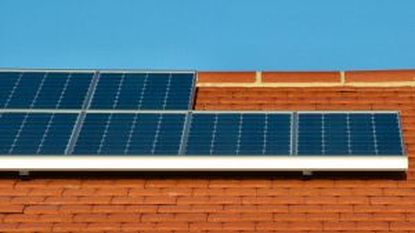3 Biggest Misconceptions About Renewable Energy

The 21st century has brought with it various advancements which are impressive; be those cell phones which can access the internet, or new, insanely fast forms of travel such as the hyperloop.
But even as our technology is progressing by heaps and bounds, most of our devices and ways of life are powered by antiquated fossil fuels which are leaving a trail of destruction of the likes our world has never known.
(Fabiennew / FreeImages)
Right now we are at a crossroad where fossil fuels are beginning to look like they are better of relegated to the annals of history, and renewable sources of energy such as solar power, geothermal and wind, are what we should be taking more seriously.
Despite the fact that renewable energy helps overcome many of the problems that fossil fuels present, there are still a lot of misconceptions doing the rounds regarding it.
Let’s take a look at 3 of the top myths about renewable energy:
Misconception #1 -– Clean coal:
Coal accounts for a major part of the world energy production and is also one of the dirtiest ways we can produce power. For example, power generation from coal is responsible for 59% of United States sulfur dioxide pollution.
Pollution from coal-fired plants also leads to smog, depletion of ozone and health problems among residents living near coal-fired plants. Of course, let’s not forget about the dangers of mining it.
Clean coal technology was thus recommended as an alternative until a suitable replacement could be found. However right from its inception, clean coal has been criticized for being a facelift rather than a real solution to the pollution coal causes.
A large portion of making coal clean requires capturing its polluting agents and storing it away, usually in dried up oil fields or under the sea.
Critics have pointed that this is redirection of pollution, not its elimination. These deposits also have to be observed constantly to ensure they are not endangering the eco-system, which they eventually do.
Misconception #2 -- Solar power is too weak
We don’t see too many fast cars or bikes with solar panels on them, which has given people to the idea that solar power simply isn’t powerful enough. True, in its current iteration solar power contributes to a very minuscule 0.8% of the entire world’s power production. But think about it for a second, this is energy from our neighboring star we are talking about!
In fact, all life on earth has solar energy to thank for its existence, so clearly our effort to convert the energy from the sun into usable power is somewhat lacking.
However, with each passing year, the efficiency of solar or photovoltaic cells is rising and it can become an increasingly dominant source of energy down the line. Solar power adoption in the US, as well as around the world is increasing exponentially. In US alone, photovoltaic operating capacity has touched 15.9 gigawatts, enough to power over 3.2 million homes.
New generation light harvesters such as those using perovskite and quantum dots are paving the way to a cleaner tomorrow. While both of these are still at least a decade away from seeing the light of day (pun intended), the conversion efficiency and cost effectiveness they promise are far greater than what is commercially available right now.
Misconception #3 –- Government subsidies are wasted on renewable energy technologies
Most critics of renewable energy say that had it not been for government grants, most projects such as solar power would have died out long ago. However, they conveniently ignore even non-renewable sources of energy such as oil and gas are heavily subsidized by governments in order to make them more economically viable. It is because of government subsidization that trillions of dollars worth of infrastructure needed to sustain fossil fuel entrenchment occurred in the first place.
Simply put, a program receiving financial help from governments does not mean it will fail in its absence. Currently, the entry barriers to new technologies in the energy market are higher than in any other industry. Federal subsidies are provided so that emerging technologies can catch up with existing energy production methods.
US government’s policies also have been very successful so far. For instance, Solar Investment Tax Credit (ITC), Net Energy Metering (NEM) and Renewable Portfolio Standards (RPS) have allowed renewable sources of energy such as solar power to become more popular, and are paying back $15 billion per year worth of dividends to the US economy.
Ultimately the subsidization of renewable sources of energy only serves to diversify and strengthen the energy market by providing more options to the consumer. More sources of energy will also protect against price shocks and keep energy prices down via competition. The benefits that we stand to reap from renewable sources of energies are well worth the subsidies, especially since they only cost the government a small percentage of its total budget expenditure.
But even as our technology is progressing by heaps and bounds, most of our devices and ways of life are powered by antiquated fossil fuels which are leaving a trail of destruction of the likes our world has never known.
(Fabiennew / FreeImages)
Right now we are at a crossroad where fossil fuels are beginning to look like they are better of relegated to the annals of history, and renewable sources of energy such as solar power, geothermal and wind, are what we should be taking more seriously.
Despite the fact that renewable energy helps overcome many of the problems that fossil fuels present, there are still a lot of misconceptions doing the rounds regarding it.
Let’s take a look at 3 of the top myths about renewable energy:
Misconception #1 -– Clean coal:
Coal accounts for a major part of the world energy production and is also one of the dirtiest ways we can produce power. For example, power generation from coal is responsible for 59% of United States sulfur dioxide pollution.
Pollution from coal-fired plants also leads to smog, depletion of ozone and health problems among residents living near coal-fired plants. Of course, let’s not forget about the dangers of mining it.
Clean coal technology was thus recommended as an alternative until a suitable replacement could be found. However right from its inception, clean coal has been criticized for being a facelift rather than a real solution to the pollution coal causes.
A large portion of making coal clean requires capturing its polluting agents and storing it away, usually in dried up oil fields or under the sea.
Critics have pointed that this is redirection of pollution, not its elimination. These deposits also have to be observed constantly to ensure they are not endangering the eco-system, which they eventually do.
Misconception #2 -- Solar power is too weak
We don’t see too many fast cars or bikes with solar panels on them, which has given people to the idea that solar power simply isn’t powerful enough. True, in its current iteration solar power contributes to a very minuscule 0.8% of the entire world’s power production. But think about it for a second, this is energy from our neighboring star we are talking about!
In fact, all life on earth has solar energy to thank for its existence, so clearly our effort to convert the energy from the sun into usable power is somewhat lacking.
However, with each passing year, the efficiency of solar or photovoltaic cells is rising and it can become an increasingly dominant source of energy down the line. Solar power adoption in the US, as well as around the world is increasing exponentially. In US alone, photovoltaic operating capacity has touched 15.9 gigawatts, enough to power over 3.2 million homes.
New generation light harvesters such as those using perovskite and quantum dots are paving the way to a cleaner tomorrow. While both of these are still at least a decade away from seeing the light of day (pun intended), the conversion efficiency and cost effectiveness they promise are far greater than what is commercially available right now.
Misconception #3 –- Government subsidies are wasted on renewable energy technologies
Most critics of renewable energy say that had it not been for government grants, most projects such as solar power would have died out long ago. However, they conveniently ignore even non-renewable sources of energy such as oil and gas are heavily subsidized by governments in order to make them more economically viable. It is because of government subsidization that trillions of dollars worth of infrastructure needed to sustain fossil fuel entrenchment occurred in the first place.
Simply put, a program receiving financial help from governments does not mean it will fail in its absence. Currently, the entry barriers to new technologies in the energy market are higher than in any other industry. Federal subsidies are provided so that emerging technologies can catch up with existing energy production methods.
US government’s policies also have been very successful so far. For instance, Solar Investment Tax Credit (ITC), Net Energy Metering (NEM) and Renewable Portfolio Standards (RPS) have allowed renewable sources of energy such as solar power to become more popular, and are paying back $15 billion per year worth of dividends to the US economy.
Ultimately the subsidization of renewable sources of energy only serves to diversify and strengthen the energy market by providing more options to the consumer. More sources of energy will also protect against price shocks and keep energy prices down via competition. The benefits that we stand to reap from renewable sources of energies are well worth the subsidies, especially since they only cost the government a small percentage of its total budget expenditure.
